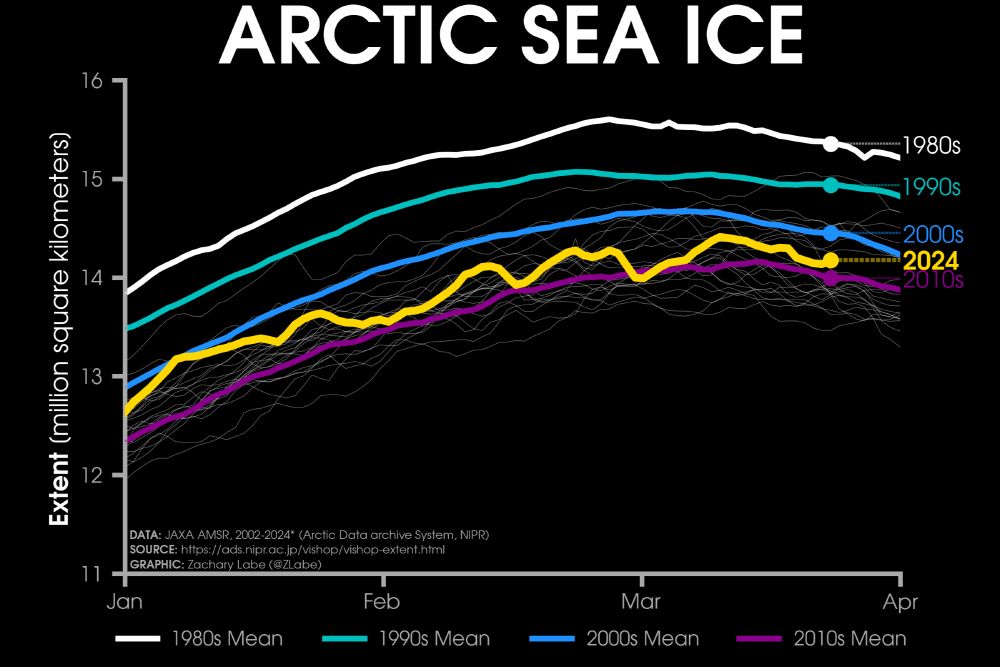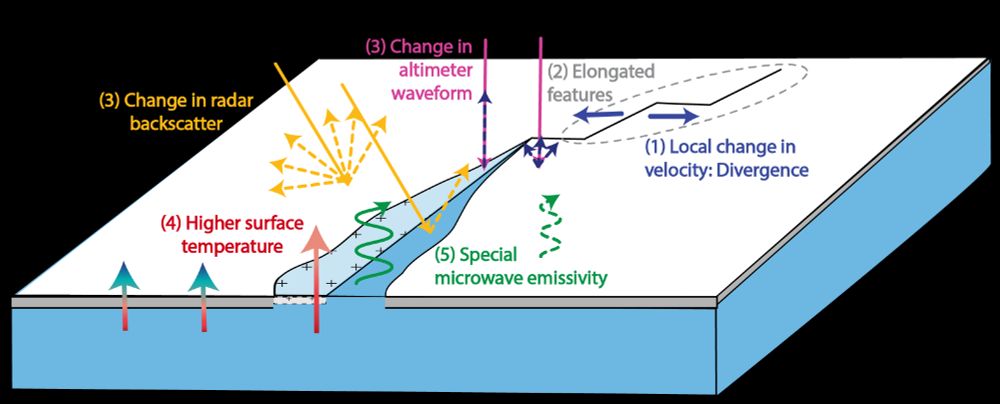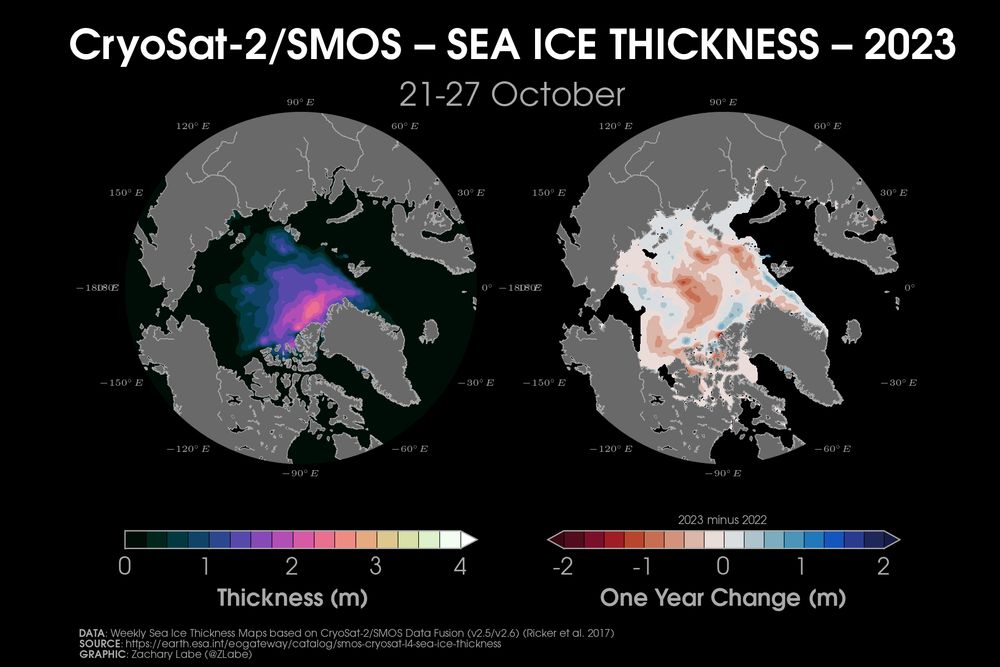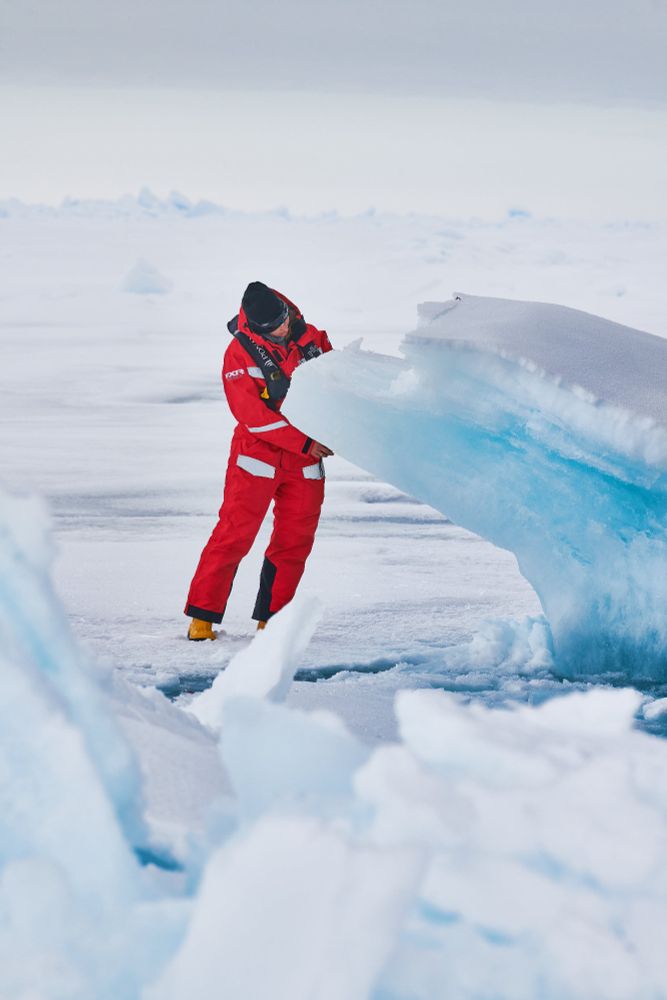
Line graph time series of 2024's daily Arctic sea ice extent compared to decadal averages from the 1980s to the 2010s. The decadal averages are shown with different colored lines with white for the 1980s, green for the 1990s, blue for the 2000s, and purple for the 2010s. Thin white lines are also shown for each year from 2002 to 2022. 2024 is shown with a thick gold line. There is a long-term decreasing trend in ice extent for every day of the year shown on this graph between January and April by looking at the decadal average line positions.
Monday ice update - #Arctic sea ice extent is currently the 15th lowest on record (JAXA data)
• about 180,000 km² above the 2010s mean
• about 280,000 km² below the 2000s mean
• about 760,000 km² below the 1990s mean
• about 1,180,000 km² below the 1980s mean
Plots zacklabe.com/arctic-sea-i... 🧪⚒️
25.03.2024 13:39 — 👍 9 🔁 5 💬 0 📌 0

We compared our new lead product to other lead products - not straightforward! Because all sensors measure different lead properties, the results can be quite different. We suggest to distinguish between "open-water fraction" and "lead fraction including thin ice".
19.03.2024 16:07 — 👍 1 🔁 0 💬 0 📌 0

We derived a time series of lead fractions for the yearlong MOSAiC
drift campaign (2019/2020) showing different phases of high and low lead activity.
We looked at leads of different ages from 0 to 10 days old.
Does that fit with your observations of the sea ice dynamics? - Let us know!
19.03.2024 16:06 — 👍 1 🔁 0 💬 1 📌 0
🌊❄️ 💔Curious about wintertime leads in the Arctic sea ice?
➡️ Sea ice dynamics can tell you much more!
🛰️ We have used divergence derived from SAR satellite data to study the presence and formation history of leads.
Where-when-how wide are leads?
Read more here: tc.copernicus.org/articles/18/...
19.03.2024 16:05 — 👍 3 🔁 1 💬 1 📌 0
Under the hypothesis that water vapor transport links the sea ice🔛cloud's complex interaction, we found "Asymmetries in cloud microphysical properties ascribed to sea ice leads… in the central Arctic" #MOSAiC #expedition #polar #atmospheric #science #leipzig #AC3 acp.copernicus.org/articles/23/...
27.11.2023 18:12 — 👍 6 🔁 3 💬 0 📌 0

Two polar stereographic maps showing Arctic sea ice thickness from CryoSat-2/SMOS and the difference relative to the previous year (October 2022 to 2023).
A first look at the CryoSat-2/SMOS merged product for Arctic sea ice thickness this fall - sea ice is thinner than last year across most of the ice pack
This graphic will now be updated weekly at zacklabe.com/arctic-sea-i...
29.10.2023 19:12 — 👍 43 🔁 17 💬 1 📌 0

Hi Bluesky community 👋 - I am happy to have joined you :) Looking forward to connecting with fellow 🧊Cryosphere and 🛰️ Earth Observation Enthusiasts and Science Communicators! Can't wait to share my work, images, ideas, and passion for the ice with you all.
Picture: Mike Louagie
23.10.2023 07:51 — 👍 27 🔁 4 💬 1 📌 1
Arctic Climate Scientist ❄️. NSF Postdoc Fellow at Colorado State University. Passionate about ECR community building, DEI, and mentorship
European Geosciences Union is the leading organisation supporting Earth, planetary & space science researchers in Europe. #EGU26 3-8 May 2026. Online Mon-Fri 10-5 CET.
Climate scientist investigating weather and climate extremes, professor at ETH Zurich (@ethzurich.bsky.social), fascinated by weather and climate, IPCC AR6 lead author
Climate scientist at DMI, Greenland, Antarctica, polar regions in general.
Dipping a toe in yet another social media site. Mostly on mastodon though @ruth_mottram@fediscience.org
Blogging at sternaparadisaea.net
Global climate science and policy institute working to accelerate climate action and keep warming below 1.5°C.
Climate, deep ocean, Arctic, cats.
Rarely online, regardless of the platform
Postdoc in sea ice physics. Hobbies include swimming, running, and reading. He/him. 🏳️🌈
The #CopernicusClimate Change Service (#C3S) & #CopernicusAtmosphere Monitoring Service (CAMS), implemented by @ecmwf.int on behalf of the European Commission.
Climate and graphics at @nytimes.com
Email me and check my work: harry.stevens@nytimes.com
Arctic Science Communicator. Indigenous Data Sovereignty Advocate. Apache, Yaqui and British Descent.
European with a German accent.
Communications for research in AI.
Posts auf Deutsch, in English et parfois même en français.
Essen, Brüssel, Saarbrücken, Paris, Frankfurt, Berlin.
Coastal Sea Research; Baltic Sea Research; official bluesky account of Leibniz Institute for Baltic Sea Research Warnemünde (IOW): https://www.io-warnemuende.de
Associate professor of remote sensing of cryosphere at UNIS Svalbard.
Doctoral Researcher working on Antarctic ice dynamics at PIK Potsdam and MPI-GEA 🇦🇶🧊
Co-Chair of APECS Germany ❄️
Junior Chief Editor at PolF 📑
Views are my own.
Climate scientist fascinated by polar regions, ocean, ice, and the global carbon and water cycles
25 Meeresforschungs-Einrichtungen, ein Ziel: den nachhaltigen Umgang mit Küsten, Meeren und Ozeanen zu stärken. 🌎 https://allianz-meeresforschung.de / @Allianz_Meer@wisskomm.social
Scientist / Research Polar 🌨️.
Leibniz Institute of Atmospheric Physics. Rostock University. 🇩🇪
#JuliaLang 👨🏽💻🎾☕.
https://pablosaa.github.io
Remote sensing of our living environment from space-borne to UAS/UAV, from the tropics to the Arctic -- at @uni-wuerzburg.de, Germany -- https://www.remote-sensing.org http://www.earth-observation.org - managed by Dr Martin Wegmann
Hier schreibt die Regionalgruppe Frankfurt am Main der @de.scientists4future.org. Wir machen Wissenschaftskommunikation für alle und unterstützen die @fridaysforfutureffm.de
Postdoc | Marine biologist working with ocean biogeochemistry models | Member of AWIs4Future and Scientists4Future | Views are my own





